|
Quilt History
Today's Quilt Historians
Underground Railroad
Women at Work
|
|
from a private collection
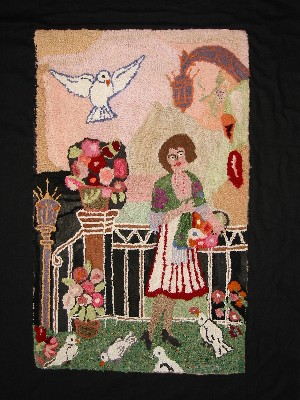 The
technique of pulling a loop of one fiber through a woven foundation has
probably been done since the earliest manipulations of textiles. Examples of
the technique can be seen in 4th century. Egyptian textiles where remnants
of wool tufts were pulled through a linen base. Various sources attribute
the Scandinavians during the Bronze Age of practicing the technique and
passing it along to the British Isles and onward to the Canadian Maritime
Provinces and the Northeastern United States. That said, rug hooking as we know it today has
been practiced for fewer than 200 years. Whatever the source of origin, it is
clear that hooked rugs developed, flourished and blossomed into an amazing
variety of styles in northeast North America. Though the making of hooked rugs
has now spread around the world they might almost be considered indigenous to
the NE of North America. The
technique of pulling a loop of one fiber through a woven foundation has
probably been done since the earliest manipulations of textiles. Examples of
the technique can be seen in 4th century. Egyptian textiles where remnants
of wool tufts were pulled through a linen base. Various sources attribute
the Scandinavians during the Bronze Age of practicing the technique and
passing it along to the British Isles and onward to the Canadian Maritime
Provinces and the Northeastern United States. That said, rug hooking as we know it today has
been practiced for fewer than 200 years. Whatever the source of origin, it is
clear that hooked rugs developed, flourished and blossomed into an amazing
variety of styles in northeast North America. Though the making of hooked rugs
has now spread around the world they might almost be considered indigenous to
the NE of North America.
Before 1780, in America most floors were bare, especially among the poor. The
better off may have decorated their floors with paint, stenciling, painted floor
cloths or even sand swept into designs. Only the wealthy would have had the
means to own imported carpeting, as the domestic textile industry was in its
infancy. It wouldn't get fully underway until the second quarter of the 19th
century, so most of the goods were imported from England.
The early forerunners of the hooked rug were not pieces made for the floor, but
for tables or beds, as Bed Ruggs, followed by hearth rugs made to protect
expensive carpeting from soot and embers. Though technically not hooked, but
yarn sewn, these rugs would resemble the hooked rugs to come. Yarn sewn rugs
are not to be confused with rugs hooked with yarn; they are different techniques
and though the surface may look similar, the back of the foundation will clarify
which technique was used.
Most of the yarn sewn pieces would have been worked on a linen or wool
foundation with needle and yarn. Cotton was more expensive, making it less
available, except to the more affluent in the US. Though wool and linen could be
processed and woven locally, the processing of cotton needed more elaborate
technology. That technology was hindered and limited in the States by the
British Acts of Trade; which weren't fully repealed until 1849. Before that,
much of the raw cotton produced in the US was exported to England for processing
and then imported as yardage.
Shirring was another technique used in the 2nd quarter of the 19th century.
Fabric would be folded, gathered or pleated and then sewn to the surface of a
foundation. Any rugs truly hooked in the first half of the 19th c. would have
been through a closely woven foundation. Most of these variations would have
been made and owned by the wealthy. Generally speaking, those are the rugs that
have survived.
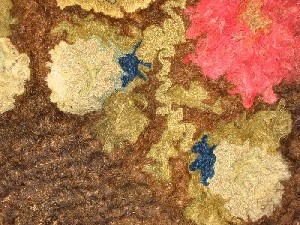
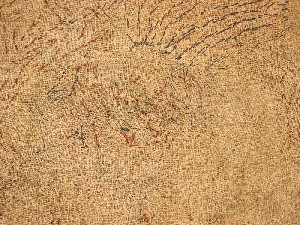
shirred rug detail of front
and back, c.1830, wool on linen
Courtesy of Collection of Jan Whitlock Textiles
Full shot 33" x 36"
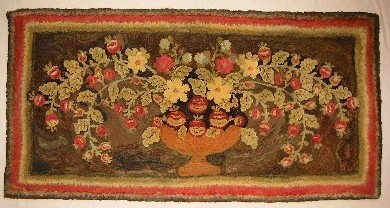
By the 1850s marked changes in life were well under way; expansion of
technology, opening of imports from foreign countries no longer restricted by
England, mechanization in all aspects of life, migration not only into the
cities but out to the Western frontiers and immigration from overseas to name a
few. It was also the time of the biggest change in the making of hooked rugs.
That change came in the form of sacking, the type used on imported coffee, tea,
grain, tobacco etc. from the West Indies. The sack was made in burlap, a woven
fabric made from a bast plant or stalk fiber, jute. Burlap would mark the
expansion of rug hooking and cause the other forms (yarn sewn and shirring) of
rug making to be left behind. The burlap would be salvaged and used for the
foundations of hooked rugs. Its wider weave structure facilitated the hooking
process making it easier to pull strips of fabric through it. It was widely
available especially in rural areas. It was very strong when new and best of all
it was cheap, if not free. Thus burlap made it possible for the lower economic
levels to create hooked rugs that would emulate the floor coverings of the
wealthy for little or no cost, when hooking with strips of fabric culled from
old and worn out clothing, or using remnants from the textile mills that were
multiplying.
19th C. CANADIAN RUG RHYME
I am the family wardrobe, best and worst of all the generations from the
first,
Grandpa's Sunday-go-to-meetin' coat,
And the woolen muffler he wore at his throat;
Grandma's shawl, that came from Fayal;
Ma's wedding gown, three times turned and once let down,
Which once was plum but now turned brown;
Pa's red flannels, that made him itch;
Pants and shirts; petticoats and skirts;
From one or another, but I can't tell which.
Tread carefully, because you see, if you scuff me.
You scratch the bark of the family tree.
Though burlap is strong when new, it does not retain its durability and may
weaken long before the rugs hooking material wears out. If the burlap had served
as cargo or feed sacking it was already on its second use when used as the
foundation for a rug. The life of a rug, no matter what its content, can be a
hard one and many early rag hooked rugs did not survive. It was common practice
to place a newly made rug in the most prominent room. As they wore, they would
be moved to locales of less importance to be replaced by a newer rug, eventually
working their way out the back door to the woodpile or barn. Many rugs were
utilitarian. Their value as a historical textile link was not realized and when
they wore out, they were discarded. This could explain why many more
"show" rugs have survived than the purely utilitarian common rug.
Burlap foundations are one of the biggest concerns of antique rugs today.
|
|
The
Complete Guide to Collecting Hooked Rugs: Unrolling the Secrets
by Jessie A. Turbayne
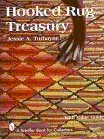
Hooked Rug Treasury
Jessie A. Turbayne 1997 Schiffler Publishing Co.
Hooked
Rugs: History and the Continuing Tradition
by Jessie A. Turbayne
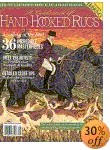
Celebration
Xiii: Showcase of Commercial Designs and Adaptations (Celebration of
Hand-Hooked Rugs)
by Rug Hooking

Purely
Primitive: Hooked Rugs from Wool, Yarn, and Homespun Scraps
by Pat Cross
The
Hooker's Art: Evolving Designs in Hooked Rugs
by Jessie Turbayne

Hooking Rugs
Lila Fretz 1990 Garden Way Publishers
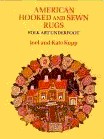
American Hooked and Sewn Rugs: Folk Art Underfoot
Joel and Kate Kopp 1975/1985 E.P. Dutton & Co. Inc. |
|
Hooking was the one needlework that could be done by even those
at the lowest economic level; no other needlework was made from
worn out clothing or the unraveling of the burlap foundation, to
be used as a hooking material. The supplies needed could be as
humble as four boards nailed together and a hook fashioned from
a bent nail inserted in a wooden handle. Hooking could also be
upgraded by those of more means with the purchase of better
newer fabric.
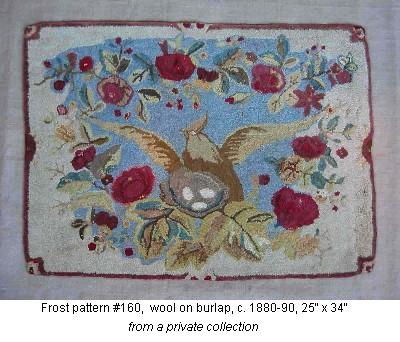
The introduction of burlap in the 1850s was well timed with the
proliferation of the textile mills and the availability of
fabrics at cheaper prices. With the increase in hooking came an
incredible profusion of hooking gadgets and printed patterns led
by the entrepreneurial spirit in 1868 of Edward Sands Frost of
Biddeford, Maine. While on his journeys as a peddler and after
he saw a need for them, Frost made the first pre-stamped
patterns on burlap for rug hooking.
As the demand grew and free hand drawing was too labor
intensive, he came upon the idea to print the designs from
stencils he could make using the metal from old copper boilers.
In 1870 he started printing them in color. When Frost moved west
for his health, James A. Strout bought the Frost business in
1876 and ran it until 1900. Others soon followed with their
patterns and gadgets. In 1886, Ebenezer Ross of Toledo, Ohio
started and invented a gadget called the Novelty Rug Machine
that used yarn instead of cut strips of cloth. This technique
today is referred to as needlepunch. Many rug hookers would
personalize the patterns and add their own design elements. No
rugs from the same pattern would come out the same, given the
variety of materials used to make them. Even so, they were
instrumental in limiting originality and creativity though these
businesses are credited for popularizing and expanding interest
in the craft.


Needlepunched
rug likely a Ross pattern c. 1900-1910, detail of back on right, wool yarn
on burlap feed sacking, aprox. 29" x 45"
Courtesy of the collection of Ron Tauss.
The last half of the 19th century was a time of rapid change:
synthetic dyes were being discovered (by 1902 nearly 700
synthetic dyes were available), industries were expanding,
inventions and discoveries in all areas were being made,
electricity, telephones, steel construction in buildings, travel
expansion, medical advances, the transatlantic cable etc. The
Industrial Revolution in America was well on its way.
It seemed that the momentum was for more and more, done faster
and faster, to be cheaper and cheaper. As production for
consumer goods intensified and prices declined the quality of
goods suffered. So it was with hooked rugs as well, as William
Winthrop Kent noted in THE HOOKED RUG (1937), "The deterioration
in the design of the hooked rug came with the commercializing of
the design itself by the stamping or stenciling of bad stock
designs on burlap for the trade. These were not always bad but
often execrable" (i.e., extremely inferior, hateful).
By the end of the 19th century, the popularity of hooked rugs
was at an ebb. Fashions, styles, available time and economic
positions had changed. The "quaint" homemade hooked rug would be
replaced by the "modern" factory produced carpet. Also now, in
reaction to what was seen as the homogenization of the
individual and the reduction of man to yet another cog in the
industrial process, an anti-modernism movement gained momentum
and cottage industries started up to counter what was seen as
bad designs made cheaply. Their purpose was to supply better
made and designed rugs to a growing middle class and provide
work for those in need. One was Abanakee Rugs of New Hampshire,
a company started by Helen Rickey Albee in 1894 using Native
American motifs as design inspiration. Another began in 1902,
the Subbekashe Rug Industry in Belchertown, Mass. where Lucy
Thompson also used Native American designs as sources for her
rug patterns.
from the Grenfell Industries, aprox 18" x 24"
Courtesy of the collection of Laura Fisher Antiques
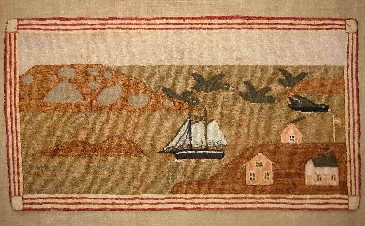
Perhaps the best known of the cottage businesses is the Grenfell
Industries. Dr. Wilfred Grenfell opened the Grenfell Mission in
1893 to help the desperately poor in Newfoundland and Labrador.
As hooking had a long history in Canada, he saw an opportunity
for the fishing families to earn some much needed money in the
off season by making hooked mats to sell. The arrival of Jessie
Luther at the mission in 1907 markedly improved the design and
color of the rugs making them quite sought after by tourists.
The earlier rugs were hooked with cotton flannelette and later
in the 30s and 40s, with collected and dyed silk and rayon knit
hosiery. These rugs today are highly prized and very distinctive
in style and subject.
In the 1920s, still more rug hooking industries developed, such
as; Maine Seacoast Missionary Society, South End House Industry
in Boston, and Cheticamp Hooked Rug Industry in Cape Breton,
Nova Scotia. This one was started by Mrs. Alexander Graham Bell
and is still in business.
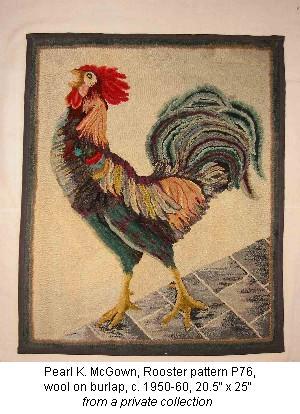
With the proliferation of the cottage industries, the homemade
rug went out of style until a resurgence of interest in the 30s
and 40s. This was in large part thanks to William Winthrop Kent,
an architect and hooked rug authority. He felt that old rugs
should be saved and hung as art and new ones be made for the
floor. His three books on hooked rugs (the first in 1930 THE
HOOKED RUG) promoted appreciation for early rugs and encouraged
the making of new ones, using better designs than those of the
late 19th century. About this time Pearl McGowan was also
teaching and raising awareness of the craft of rug hooking.
Whereas before, most any type of leftover fabric was used for
rug making, now wool became the dominant component. Improvement
in the standard of living and an increase in discretionary
income for the expanding middleclass, made it feasible for wool
to be purchased and dyed specifically for rug making. Wool
became the dominant material in hooked rugs and remains so
today.
Interest in rug hooking once again seemed to wane in the 50s and
60s as styles changed. A rug show in 1974 at the Museum of
American Folk Art (now American Folk Art Museum) in NYC, curated
by Kate and Joel Kopp, once more made apparent the beauty and
historical value of this form of needlework. A year later, the
Kopps followed up with their book
AMERICAN HOOKED AND SEWN RUGS. Joan Moshimer helped fire up
the interest in contemporary rugs with the opening of her
hooking business in Kennebunkport, Maine.
Rug hooking has gone through many ins and outs of popularity as
well as ups and downs in esthetic and technical quality. Today
it is once again growing and expanding. Printed designs, cottage
industries making finished rugs to order, commercially and hand
dyed wools are widely available. Far surpassing the original
bent nail and four boards nailed together for a frame, many
tools are now available; designer hooks, cutters, frames and
stands. Classes, books, shows, workshops, lectures, seminars,
internet posting groups, camps and guilds are multiplying to the
ever growing interest and participation in rug hooking. Museums
and galleries are mounting hooked rug shows, recognizing both
the old and the contemporary.
There is an amazing and impressive amount of original designing
being done today as well. Rug hooking is an example of how a
humble craft, born of leftovers and cast off clothing to produce
utilitarian goods has blossomed into a medium for textile design
and gained recognition as an art form.
Hooked rugs fill a special need. Like quilts, they are a way to
be creative and expressive as well as make something both
functional and attractive. Hooked rugs can be a physical
registry of the life of the maker. They contain the shirt off
their back, the socks from their feet and other materials that
had been used up and worn out. Now they begin a new life. A
hooked rug can quite literally give a closet full of information
about the maker's station in life.
Today's rugger may not need to use worn out clothes and
cast-offs, though for some it is a choice. The need to create
and express one's ideas and designs as well as beautify one's
surrounding is a constant in all art forms.
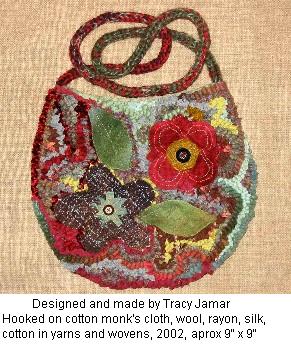 REGIONAL
DESIGNS REGIONAL
DESIGNS
As with quilts, different regions had their particular design
styles and patterns. Several rug styles can be assigned to
specific regions in Canada. Inch mats (small squares arranged by
color to form a pattern) were as common in Nova Scotia, as
basket weave patterns were familiar in New Brunswick and as
black outlined forms were to Prince Edward Island. Maple leaves
and beavers were a sign of Canadian origin. A sculpted 3-D
effect was originally known as "Acadian" now known as the
Waldoboro style from the town of the same name in Maine. Many
hookers used elements from their everyday life as inspiration,
nautical themes, farm animals, pets and buildings, which might
give an idea as to the maker's location. With the spread of
patterns through magazines and newspapers the distinctions
blended.
Tracy's bio and services offered
Tracy Jamar has been restoring antique textiles since 1979,
where she was head of restoration and conservation services for
the well respected gallery, America Hurrah Antiques, NYC. The
opening of her own studio, Jamar Textile Restoration Studio
located in NYC in 1985, allowed her restoration and conservation
services to be offered directly to private collectors and
antiques dealers.
Her experience has included the restoration of all forms of
quilts, pieced and appliquéd, including Baltimore Album,
broderie perse, unusual pictorial and figural quilts and Bed
Ruggs. She also restores American floor coverings including
hooked, yarn sewn, shirred and rag rugs.
Many of the items restored by Tracy Jamar are in major American
museums and important private collections. A rare Bed Rugg she
restored is currently in the collection of the American Folk Art
Museum in NYC where she has lectured on the care and restoration
of hooked rugs and quilts.
Tracy prepares textiles for mounting and hanging and offers
consultation about a variety of display options. She is one of
the creators of the Walker Display Textile Hanging System. She
is known for her swift, competent and reliable service and can
offer excellent references upon request. Though located in NYC,
clients send her their textiles from across the US.
For information call 212.866.6426 or e-mail
tjamar@optonline.net.
Or, visit her Web site:
www.tracyjamar.com
Click here
for hooked rug information
sources. |
|
*
Hooked Rugs History and Patterns
© 2004 - 2022 Kimberly Wulfert, PhD. Absolutely no copies, reprints, use
of photos or text are permitted for commercial or online use. One personal copy for study purposes is permitted.
|
Fabrics & Dyes
Rugs & Textiles
Books & Reviews
Resource Links
Home
|